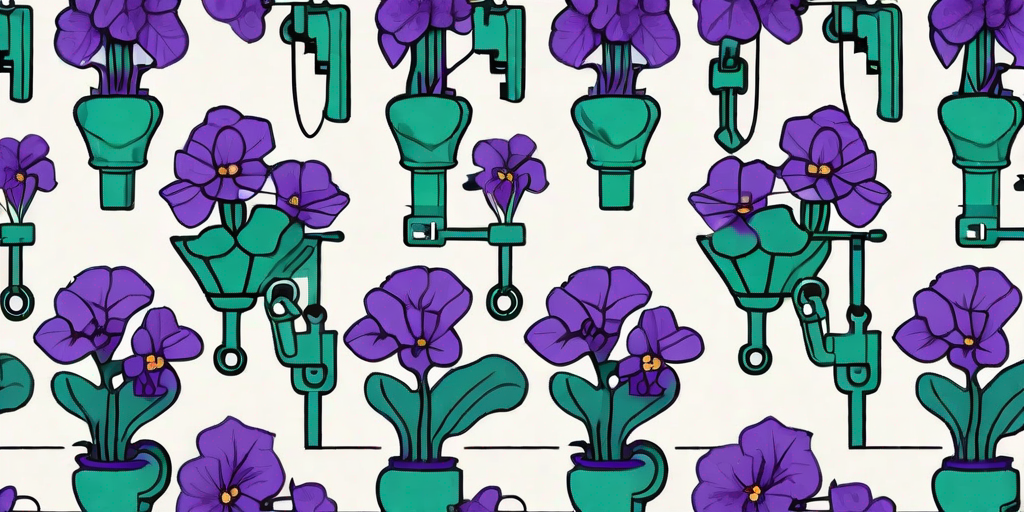
Ah, the African Violet, a plant that has baffled and bewitched gardeners for centuries. This delicate, yet stubborn, houseplant has a reputation for being a bit of a diva when it comes to blooming. But fear not, dear reader, for we are about to embark on a journey to unlock the secrets of African Violet blooming success. So, grab your watering can, put on your favorite gardening gloves, and let's get started!
The Basics of African Violet Care
Before we delve into the nitty-gritty of African Violet blooming, let's cover the basics of African Violet care. After all, you wouldn't expect a prima donna to perform without her makeup and costume, would you? Similarly, your African Violet needs the right conditions to put on its blooming show.
Firstly, African Violets prefer bright, indirect light. Direct sunlight can scorch their leaves, leading to a very unhappy plant. Secondly, they prefer a humid environment. This can be achieved by placing a tray of water near the plant or misting it regularly. Lastly, African Violets prefer a slightly acidic soil with good drainage. A soil pH between 6.0 and 6.5 is ideal.
Watering
When it comes to watering, African Violets can be a bit finicky. They prefer their water at room temperature, and they don't like to get their leaves wet. So, it's best to water from the bottom by filling the saucer under the pot. And remember, African Violets don't like to sit in water, so be sure to empty the saucer after the plant has had a drink.
Feeding
African Violets are not heavy feeders, but they do appreciate a little snack now and then. A balanced houseplant fertilizer, diluted to half strength, should do the trick. Feed your African Violet once a month, but skip the feeding in the winter when the plant is resting.
The Secret to Blooming Success
Now that we've covered the basics, let's move on to the main event: blooming. If your African Violet is not blooming, it could be due to a number of factors. Let's explore these in more detail.
Light
As mentioned earlier, African Violets need bright, indirect light to bloom. If your plant is not blooming, it might not be getting enough light. Try moving it to a brighter location, but avoid direct sunlight. Remember, African Violets are like vampires - they love the light, but it can't be too direct!
Temperature
African Violets prefer a temperature between 65 and 75 degrees Fahrenheit. If the temperature is too high or too low, it can affect blooming. So, keep your plant away from drafts and heating vents. Think of your African Violet as a Goldilocks - it likes its environment just right!
Fertilizer
While African Violets are not heavy feeders, they do need some nutrients to bloom. A lack of phosphorus can lead to poor blooming. So, make sure your fertilizer has a good balance of nitrogen, phosphorus, and potassium. And remember, it's better to underfeed than overfeed. Overfeeding can lead to salt buildup in the soil, which can harm your plant.
Common African Violet Problems and Solutions
Even with the best care, African Violets can sometimes run into problems. But don't worry, most of these issues can be easily fixed. Let's look at some common problems and their solutions.
Leaf Spotting
If your African Violet has spots on its leaves, it could be due to water splashing on them. Remember, African Violets don't like to get their leaves wet. So, always water from the bottom to avoid this problem.
Wilting
If your African Violet is wilting, it could be due to overwatering or underwatering. Check the soil to determine which is the case. If the soil is dry, give your plant a drink. If it's wet, let it dry out before watering again.
Failure to Bloom
If your African Violet is not blooming, it could be due to insufficient light, incorrect temperature, or lack of nutrients. Refer back to the blooming success section for solutions to these problems.
Frequently Asked Questions
- How often should I water my African Violet?
Water your African Violet when the top inch of soil is dry. This is usually once a week, but it can vary depending on the conditions in your home.
- Why are the leaves on my African Violet turning yellow?
Yellow leaves can be a sign of overwatering. If the leaves are yellow and the soil is wet, let the plant dry out before watering again.
- Can I propagate my African Violet?
Yes, African Violets can be propagated from leaf cuttings. Simply cut a leaf with its stem, place it in a pot with moist soil, and wait for it to root.
Conclusion
And there you have it, the secret to African Violet blooming success. With the right care and a little patience, you too can enjoy the beautiful blooms of this wonderful houseplant. So, go forth and bloom, dear reader, bloom!















